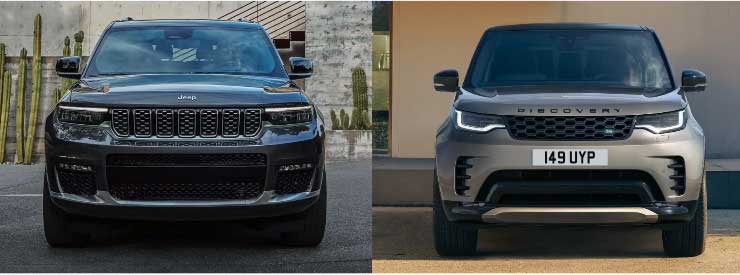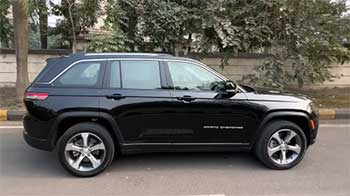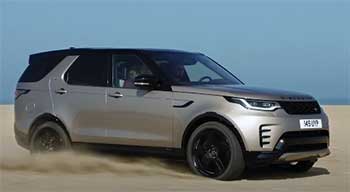I’ve always been fascinated by SUVs that promise both rugged capability and refined luxury, and two models that consistently catch my eye are the Jeep Grand Cherokee and the Land Rover Discovery. These midsize SUVs blend off-road prowess with upscale interiors, but which one truly delivers for you?
In this article, I’ll compare their key features, weigh their pros and cons, and help you decide which SUV suits your lifestyle.From performance to pricing, let’s explore what sets these vehicles apart.

Comparison Table: Jeep Grand Cherokee vs. Land Rover Discovery
| Feature | Jeep Grand Cherokee | Land Rover Discovery |
| Base Price (2025) | $38,290 | $61,825 |
| Base Engine | 3.6L V6 (293 hp) | 2.0L P300 (296 hp) |
| Fuel Economy (mpg) | 19 city / 26 highway | 19 city / 24 highway |
| Towing Capacity | Up to 7,200 lbs | Up to 8,200 lbs |
| Cargo Space (cu. ft.) | 37.7 (seats up) / 70.8 (seats folded) | 9.1 (seats up) / 74.3 (seats folded) |
| Seating Capacity | 5 (7 with Grand Cherokee L) | 7 |
| Infotainment Screen | 10.1 inches | 11.4 inches |
| AWD Standard | No (optional) | Yes |
| Warranty | 3 years/36,000 miles | 4 years/50,000 miles |
First Impressions: Style and Presence
Driving through town in a Jeep Grand Cherokee feels like commanding a tank with a designer suit. Its bold, angular design screams American muscle, with the iconic seven-slot grille and sleek, modern lines.
The 2025 model I tested had a Summit Reserve trim, and the chrome accents and 21-inch wheels gave it a flashy, upscale vibe. It’s the kind of SUV that turns heads at the gas station, but it’s not trying too hard to be posh.
The Land Rover Discovery, on the other hand, has a more understated elegance. Its minimalist, rounded design feels like a nod to British sophistication. During my test drive, I noticed its clean lines and sleek profile made it look like it belongs in a luxury car ad, yet it’s ready to tackle muddy trails.
It’s less in-your-face than the Jeep but still commands respect.
Performance: Power and Capability
Under the Hood
The Jeep Grand Cherokee offers a 3.6-liter V6 with 293 horsepower as standard, with an optional 5.7-liter V8 pumping out 357 horsepower. The Grand Cherokee 4xe plug-in hybrid, which I drove, combines a 2.0-liter turbo four-cylinder with electric motors for 375 horsepower and 470 lb-ft of torque. It’s punchy, responsive, and surprisingly efficient, offering about 23 miles of electric-only range.
The Land Rover Discovery counters with a 2.0-liter P300 engine delivering 296 horsepower or a 3.0-liter P360 with 355 horsepower, both paired with a mild hybrid system for extra boost.
I found the Discovery’s turbocharged inline-six smoother and quieter, especially on highways, but the Jeep’s V8 felt raw and exhilarating when I floored it. The Discovery’s standard all-wheel drive (AWD) and Terrain Response 2 system make off-roading a breeze, automatically adjusting to conditions like mud or sand.
The Jeep’s Selec-Terrain system is similar, but AWD is optional, which might disappoint off-road purists.
Towing is a win for the Discovery, with a max capacity of 8,200 pounds compared to the Jeep’s 7,200 pounds. However, the Jeep’s Quadra-Lift air suspension offers a smoother ride on rough terrain, though I noticed it struggled with small road imperfections at high speeds compared to the Discovery’s more composed setup.
Interior: Comfort Meets Class
Sliding into the Jeep Grand Cherokee Summit Reserve was like stepping into a modern penthouse. The Palermo leather seats, wood trim, and 10.1-inch Uconnect 5 touchscreen felt premium yet approachable.
I loved the intuitive interface and the physical climate controls—always a plus when you’re fumbling for the AC. The optional McIntosh 19-speaker audio system was a standout, delivering crisp sound that made my road trip playlist epic.
However, the base Laredo trim feels less luxurious, and storage cubbies are limited, which annoyed me when I needed a spot for my phone.
The Land Rover Discovery’s cabin, in contrast, is a masterclass in restraint. Its DuoLeather seats, ambient lighting, and 11.4-inch Pivi Pro touchscreen create a serene, upscale vibe. I found the Discovery’s infotainment cleaner and less distracting, but it’s not as smartphone-like as the Jeep’s. The Discovery’s sliding second-row seats and larger cargo space (74.3 cu. ft. vs. Jeep’s 70.8) make it more practical for families, but the Jeep’s front seats felt slightly roomier with 41.3 inches of legroom compared to the Discovery’s 39.1.
Technology: Connectivity and Convenience
The Jeep’s Uconnect 5 system is a tech lover’s dream. It’s fast, supports wireless Apple CarPlay and Android Auto, and allows multiple user profiles—perfect for shared family vehicles. I was impressed by the optional passenger-side touchscreen, a rare feature that kept my co-pilot entertained.
However, the base 8.4-inch screen on lower trims feels dated compared to the Discovery’s standard 11.4-inch display.
The Discovery’s Pivi Pro system is sleek and user-friendly, with a larger, crisper screen that outshines the Jeep’s. Navigation Pro and the InControl App integration worked seamlessly during my drive, but I experienced occasional Apple CarPlay glitches, requiring a restart.
The Discovery’s standard wireless charging and rain-sensing wipers added convenience, though the Jeep’s optional powered gesture tailgate was a handy touch for loading groceries.
Safety: Protection on Every Journey
Both SUVs come loaded with safety features, earning high marks from me. The Jeep Grand Cherokee includes standard adaptive cruise control, blind-spot monitoring, and lane-keep assist, with the Summit Reserve adding Intersection Collision Assist—a feature I appreciated in busy city intersections. The Jeep’s NHTSA five-star safety rating and IIHS Top Safety Pick award give it a slight edge.
The Land Rover Discovery matches most of Jeep’s safety tech but adds unique features like 3D Surround Camera and Wade Sensing, ideal for off-road adventures. Its five-star ANCAP rating (based on 2017 testing) is solid, but I found the Jeep’s driver monitoring system more responsive. Both SUVs offer eight airbags, stability control, and front collision mitigation, ensuring peace of mind.
Off-Road Prowess: Tackling the Wild
I took both SUVs off-road to test their mettle, and neither disappointed. The Jeep’s Quadra-Trac II and Selec-Terrain systems handled rocky trails with ease, though the optional AWD felt less integrated than the Discovery’s standard setup.
The Grand Cherokee’s low-range gearing and hill descent control gave me confidence on steep inclines, but the air suspension felt slightly jittery on uneven terrain.
The Discovery’s Terrain Response 2 and All Terrain Progress Control shone in muddy conditions, making off-roading feel almost too easy. Its 8.3-inch ground clearance slightly edges out the Jeep’s 8.1 inches, and the Discovery’s wading depth of 23.6 inches is perfect for river crossings.
I found the Discovery’s smoother power delivery ideal for technical trails, while the Jeep’s raw power suited open, rugged terrain.
Fuel Economy and Ownership Costs
Fuel economy is a mixed bag. The Jeep Grand Cherokee’s V6 achieves 19 mpg city and 26 mpg highway, while the 4xe hybrid I tested hit 23 mpg combined with electric range for short commutes. The Discovery’s 2.0-liter engine matches the Jeep’s 19 mpg city but falls short at 24 mpg highway.
Its mild hybrid system helps, but I noticed real-world numbers were closer to 21 mpg for both.
The Jeep starts at $38,290, a steal compared to the Discovery’s $61,825 base price. However, Land Rover’s 4-year/50,000-mile warranty beats Jeep’s 3-year/36,000-mile coverage. Maintenance costs for the Discovery can sting due to premium parts, while Jeep’s widespread dealer network makes servicing easier.
Resale value favors the Jeep, with a 5-year depreciation rate of 38.9% versus the Discovery’s 54.3%.
Pros and Cons
Jeep Grand Cherokee Pros
- Powerful engine options, including a 357-hp V8 and 375-hp PHEV.
- Exceptional off-road capability with advanced 4×4 systems.
- Premium interior with up to five touchscreens and luxury features.
- High towing capacity (up to 7,200 lbs).
- Strong safety ratings and advanced driver assistance systems.
Jeep Grand Cherokee Cons
- Higher starting price ($38,490).
- Below-average fuel economy (19/26 MPG).
- Tight second-row legroom (38.2 inches).
- Average reliability (3.5/5.0) and higher repair costs ($666/year).
- Shorter warranty (3 years/36,000 miles).
Kia Sorento Pros
- Lower starting price ($33,405).
- Better fuel economy (23/31 MPG, plus hybrid/PHEV options).
- Spacious interior with seven-seat option and 41.7 inches of second-row legroom.
- Strong reliability (4.0/5.0) and lower repair costs ($533/year).
- Longer warranty (5 years/60,000 miles, 10 years/100,000 miles powertrain).
Kia Sorento Cons
- Less powerful base engine (191 hp).
- Limited off-road capability compared to Jeep.
- Cramped third row for adults.
- Smaller cargo space with seats up (12.6 cubic feet).
- Slightly lower safety rating (4.49/5.0).
Driving Experience: My Take

Behind the wheel, the Jeep Grand Cherokee feels like a muscle car disguised as an SUV. The V8’s roar and quick acceleration made my heart race, but the steering felt a tad heavy in tight corners.
The 4xe hybrid was a revelation—quiet, efficient, and still plenty powerful. Off-road, the Jeep tackled rocky paths with confidence, though I noticed some cabin noise on rough surfaces.

The Land Rover Discovery, by contrast, is all about finesse. Its steering is lighter, and the ride is smoother, especially on highways.
I felt more in control during technical off-road sections, thanks to Terrain Response 2. The cabin’s quietness was a bonus, letting me enjoy the Meridian audio system without distractions. However, the Discovery’s start-stop system felt sluggish in city traffic, which was a minor annoyance.
Family-Friendly Features
For families, the Discovery’s standard seven-seat configuration is a game-changer. The sliding second row and generous cargo space made it a hit for weekend getaways. I appreciated the powered gesture tailgate for easy loading, though the third row is best for kids.
The Jeep Grand Cherokee L offers similar seating but feels less spacious in the back. Its dual rear entertainment screens kept my passengers happy, but the Discovery’s larger cargo area won for practicality.
Luxury and Refinement
The Jeep’s Summit Reserve trim rivals luxury brands with its quilted leather and McIntosh audio. I felt like royalty, but the base trims lack that wow factor. The Discovery, even in its base S trim, exudes British elegance with DuoLeather and a panoramic roof. Its minimalist design felt less flashy but more cohesive, though the Jeep’s glitzy chrome accents appealed to my bold side.
Pricing and Value
The Jeep’s lower starting price ($38,290) makes it accessible, but fully loaded Summit Reserve models push past $80,000. I found the 4xe hybrid’s fuel savings justified the cost for city driving. The Discovery’s $61,825 base price feels steep, and its higher depreciation rate stung. However, its standard AWD and advanced tech make it a premium choice for those who can afford it.
Off-Road Adventures: My Experience
I took both SUVs on a muddy trail to test their limits. The Jeep’s Quadra-Trac II system and 8.1-inch ground clearance handled rocky terrain well, but the air suspension felt bouncy at times.
The Discovery’s Terrain Response 2 and 23.6-inch wading depth made river crossings effortless, and its smoother power delivery kept me calm under pressure. For serious off-roading, the Discovery felt more polished, but the Jeep’s raw power was a thrill.
Safety and Reliability
Both SUVs pack advanced safety features, but the Jeep’s Top Safety Pick award and responsive driver monitoring gave me extra confidence. The Discovery’s 3D Surround Camera was a standout for tight parking, but JLR’s reliability reputation raised concerns. I found Jeep’s widespread service network more reassuring for long-term ownership.
Which One Wins?
Choosing between the Jeep Grand Cherokee and Land Rover Discovery depends on your priorities. If you want affordability, bold styling, and strong resale value, the Jeep is your pick. Its V8 and 4xe hybrid offer thrilling performance, but AWD isn’t standard, and cargo space lags.
The Discovery shines with standard AWD, superior off-road tech, and a roomier cabin, but its higher price and depreciation are drawbacks. For me, the Discovery’s refined luxury and off-road finesse edged out the Jeep, but your choice hinges on budget and style preferences.
Read More: Jeep Grand Cherokee vs. Kia Sorento
Frequently Asked Questions (FAQ)
It depends on your needs. The Jeep Grand Cherokee offers better value and resale, while the Land Rover Discovery excels in luxury and off-road capability.
Jeeps generally have a better reliability reputation than Land Rovers, which have faced criticism for maintenance issues.
The Discovery compares to luxury midsize SUVs like the Jeep Grand Cherokee, BMW X5, and Mercedes-Benz GLE.
The Discovery Sport is a compact SUV with a starting price of $50,175, standard AWD, and a 10-inch touchscreen. The Grand Cherokee is a midsize SUV, starting at $38,290, with optional AWD and a 10.1-inch touchscreen. The Discovery Sport offers a third-row option, while the Grand Cherokee L provides seven seats.
Conclusion
After test-driving both the Jeep Grand Cherokee and Land Rover Discovery, I can say they’re both exceptional SUVs, each with unique strengths. The Jeep offers bold styling, affordability, and strong resale value, making it ideal for those who want power and value.
The Discovery counters with refined luxury, superior off-road tech, and a spacious cabin, perfect for families and adventure seekers. Your choice depends on whether you prioritize cost and flash (Jeep) or elegance and capability (Discovery). Which SUV speaks to you? Let’s hit the road and find out.

